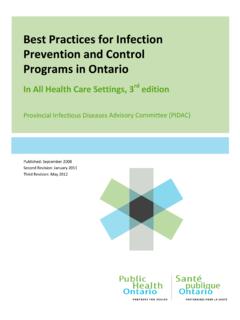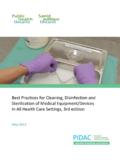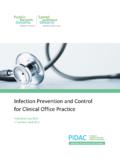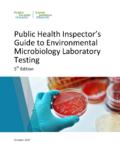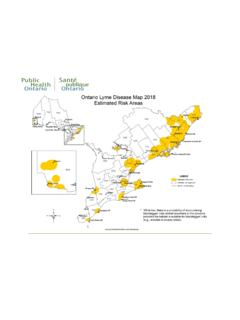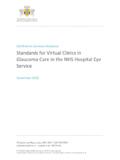Transcription of Management of patients with suspected rabies …
1 Management of patients with suspected rabies exposure Guidance for health care providers working with your local public health unit April 2017 Public Health Ontario Public Health Ontario is a Crown corporation dedicated to protecting and promoting the health of all Ontarians and reducing inequities in health. Public Health Ontario links public health practitioners, frontline health workers and researchers to the best scientific intelligence and knowledge from around the world. Public Health Ontario provides expert scientific and technical support to government, local public health units and health care providers relating to the following: communicable and infectious diseases infection prevention and control environmental and occupational health emergency preparedness health promotion, chronic disease and injury prevention public health laboratory services Public Health Ontario's work also includes surveillance, epidemiology, research, professional development and knowledge services.
2 For more information, visit How to cite this document: Ontario Agency for Health Protection and Promotion (Public Health Ontario). Management of patients with suspected rabies exposure: guidance for health care providers working with your local public health unit. Toronto, ON: Queen's Printer for Ontario; 2017. Public Health Ontario acknowledges the financial support of the Ontario Government. Queen s Printer for Ontario, 2017 Disclaimer This document was developed by Public Health Ontario (PHO). PHO provides scientific and technical advice to Ontario s government, public health organizations and health care providers. PHO s work is guided by the current best available evidence.
3 PHO assumes no responsibility for the results of the use of this document by anyone. This document may be reproduced without permission for non-commercial purposes only and provided that appropriate credit is given to Public Health Ontario. No changes and/or modifications may be made to this document without explicit written permission from Public Health Ontario. Contents Purpose .. 1 Immediate Management .. 1 Reporting to your Medical Officer of Health/public health unit .. 2 Gathering information to assess risk and determine Management of suspected rabies exposures .. 2 Resources for guidance on rabies post-exposure prophylaxis (rPEP) administration .. 3 Dogs, cats or ferrets Management of suspected rabies exposures.
4 4 Dogs, cats or ferrets Important factors to consider regarding the need for rabies post-exposure prophylaxis (rPEP) when the animal is not available for observation .. 5 Bats Management of suspected rabies exposures .. 7 Assessment of direct contact .. 7 Bat in the bedroom .. 7 Wild mammals ( , raccoons, foxes, skunks, coyotes) not including rodents Management of suspected rabies exposures .. 10 Wild and domestic rodents ( , squirrels, chipmunks, rats, mice, hamsters, guinea pigs, gerbils, ground hogs (woodchucks), and beavers) and lagomorphs ( , rabbits and hares) Management of suspected rabies exposures .. 11 Small rodents and lagomorphs: .. 11 Larger rodents.
5 11 Livestock ( , horses, cattle, sheep, goats) Management of suspected rabies exposures .. 12 Other mammals such as non-human primates, exotic species, etc., including exposures to these animals in other countries Management of suspect rabies exposures .. 12 References .. 13 Management of patients with suspected rabies exposure: Guidance for health care providers working with your local public health unit | 1 Purpose This guidance document is intended to support health care providers in working in conjunction with your local public health unit to appropriately manage persons with suspected rabies exposures. It will aid in the decision of whether to administer rabies post-exposure prophylaxis (rPEP), which consists of the following: In a previously unvaccinated person: rabies immune globulin on the first day of post-exposure prophylaxis (Day 0) and rabies vaccination on Days 0, 3, 7 and 14.
6 In those who are immunocompromised or taking antimalarial drugs, an additional dose is provided on Day 28. In a person who was previously appropriately vaccinated against rabies : only two doses of rabies vaccine are required which are given on Days 0 and 3. No rabies immune globulin is required. The Management of suspected rabies exposures involves a number of considerations, including the type of animal involved in the exposure, the details of the exposure incident, and the knowledge of animal rabies in the geographic area where the exposure occurred. Local public health units are required to conduct a risk assessment on all individuals who have had a suspected rabies While the ultimate decision to administer rPEP rests with the health care provider, the local public health unit s risk assessment provides valuable information to help determine appropriate Management of suspected rabies exposures.
7 The guidance provided in this document is based on the advice in the rabies chapter of the Canadian Immunization Guide2and the Management of Potential rabies Exposures Guideline, 2018 3. As with any guidance document, professional judgment remains essential and may result in decisions that differ from these general guidelines. Immediate Management The initial Management of any acute wound from an animal involves thoroughly cleaning the wound. The Canadian Immunization Guide advises the following: Immediate and thorough cleaning and flushing of the wound with soap and water is imperative and is probably the most effective procedure in the prevention of rabies . care should be taken to clean the wound to its full depth.
8 Flushing for approximately 15 minutes is suggested. Some guidelines also suggest the application of a viricidal agent, such as iodine-containing or alcohol solutions. Suturing the wound should be avoided if possible, and tetanus prophylaxis and antibiotics should be given as appropriate. 2 Management of patients with suspected rabies exposure: Guidance for health care providers working with your local public health unit | 2 Reporting to your Medical Officer of Health/public health unit Under Ontario Regulation 557 of the Health Protection and Promotion Act 4, health care providers are required to notify their Medical Officer of Health/local public health unit of any person who has a suspected rabies exposure.
9 This notification should occur as soon as possible and should provide the local public health unit with any available information. Gathering information to assess risk and determine Management of suspected rabies exposures Upon notification of a suspected human exposure to rabies , local public health units are required to conduct a risk assessment to determine the need for rabies post-exposure prophylaxis (rPEP). To support the risk assessment, the local public health unit s roles include: tracking the prevalence of rabies in your community; arranging for observation of the animal, if appropriate and the animal is available; assisting in locating the animal if it is not initially available; arranging for rabies testing of the animal, if appropriate and necessary; providing the medications for rPEP, if deemed necessary.
10 When working with your local public health unit, you and/or your patient will be asked to provide available information including: demographic and other relevant information about the exposed person; information about the animal, its location, its vaccination status, and its owner; details of the exposure incident. Only mammals can carry rabies . Some specific questions and considerations for suspected rabies exposures from various types of animals that can carry rabies can be found in the sections below: Dogs, cats and ferrets - page 4 Bats page 7 Wild mammals ( , raccoons, foxes, skunks, coyotes, not including rodents and lagomorphs) page 10 Wild and domestic rodents ( , squirrels, chipmunks, rats, mice, hamsters, guinea pigs, gerbils, ground hogs (woodchucks), and beavers) and lagomorphs ( , rabbits and hares) page 11 Livestock ( , horses, cattle, sheep, goats) page 11 Other mammals ( , non-human primates, exotic species) page 12 Although your local public health unit conducts the risk assessment concerning suspected rabies exposure, the ultimate decision regarding administering rPEP rests with the health care provider.



